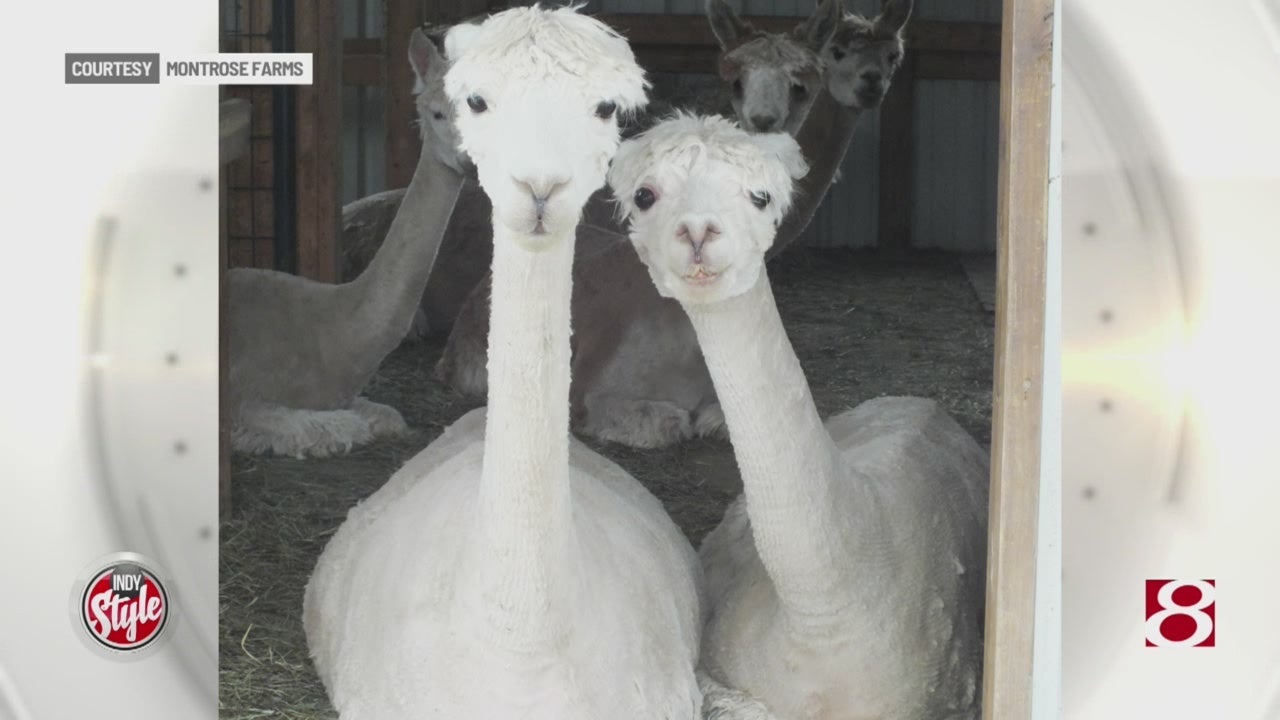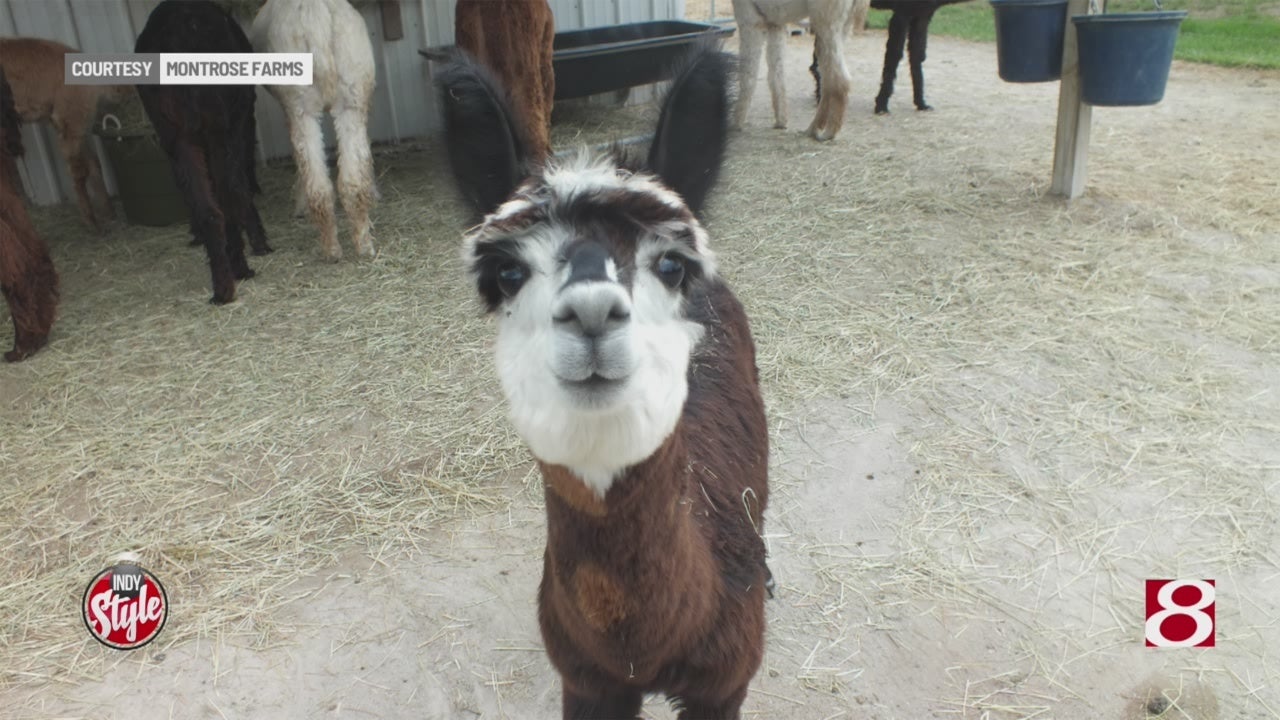Local farmer finds success raising alpacas
Why is there an alpaca in the Indy Style studio? The real question is why would there not be an alpaca in the Indy Style studio this morning?!
Local farmer finds success raising alpacas
Lori Lovely, owner of Montrose Farms, introduces one of her alpacas and shares some fun facts about the South American-native species: Lifespan: 15-25 years
Average Height: 36″ at the withers
Average Weight: 100 to 200 pounds, or about one-half to one-third the size of a llama
Average Gestation: ~50 weeks
Birth: Average birth weight is usually around 15 to 19 pounds, and babies usually stand and nurse within one hour
Color: Alpacas come in 22 official colors with many variations and blends.
There are two different kinds of alpacas in the United States: the suri alpaca, which has fiber in the form of “dreadlocks” and is very silky, and the huacaya (pronounced wa-ki-a) alpaca, which has fiber that is extremely fine and gives the alpaca a woolly, round “teddy bear” appearance. (Montrose Farms raises only suri alpacas.)
Alpacas are fiber-producing members of the camelid family (related to camels) raised exclusively for their soft and luxurious wool. Their fleeces are normally sheared once a year. Each shearing produces approximately 5-10 pounds of fiber per alpaca, per year.

Fiber Alpaca fiber is stronger and more resilient than even the finest sheep’s wool. Unlike sheep’s wool, however, alpaca contains no lanolin and is ready to spin right off the animal. It comes in 22 distinguishable colors. Alpaca fiber is considered hypoallergenic and will not irritate the skin. This is because the scales of fiber lie down against the shaft of each hair follicle. Alpaca wool is scientifically proven to be a better insulator (warmer) than sheep’s wool.Spitting
Yes, occasionally alpacas do spit to signal their extreme displeasure, fear or dominance. Male alpacas horse around, stand each other off and spit. Both males and females spit in dominance wars over food. Moms will spit at other mom’s babies who try to suckle or mount her or get too close to her newborn. There are variations of spit: air, grass, regurgitated stomach contents that are currently being re-chewed.
Vocalizations
Alpacas use complex sets of sounds to communicate with each other. Humming is the predominant sound you hear when you come to an alpaca ranch. Alpacas hum for many reasons. From birth until at least six months, mothers and their crias hum to each other constantly. As a sign of distress at separation from each other, alpacas will hum mournfully. Alpacas hum when they are curious, content, worried, bored, fearful, distressed or cautious.
Clucking Mothers generally cluck to their crias, particularly when starting to nurse.
Alarm Call When something unusual or resembling a predator appears in the vicinity, alpacaa will sound a high-pitched, rhythmic braying sound (like a donkey), which causes the herd to bunch up for protection.
Orgling Male alpacas have a unique throaty vocalization they make when mating, sort of like a cross between a yodel and a gargle.
Are alpacas dangerous?
Absolutely not! They are safe and pleasant to be around. They are very curious about people and seem most intrigued and drawn to children. Alpacas are becoming a popular animal for 4H projects. They do not bite or butt; and they do not have the teeth, horns, hooves or claws to do serious injury.
Import
The first alpacas were imported in the early 1980s from Chile. Peru and Bolivia were closed to exports due to hoof and mouth disease until 1992, then from 1993-1998 alpacas were also imported from Peru. The imports were run from 1993-1998 by the Alpaca Registry Inc. In 1998 they closed the registry to imports or new animals. Like most good registries, you could only register animals that come from two registered parents. The Alpaca Registry is the largest fully verified DNA-typed livestock registry in the world, with over 200,000 animals. This protects the quality of the North American herd and was designed to help eliminate llama admixture by using judges to select only animals without any llama like traits and the best alpaca traits.

Misc.
Alpacas are modified ruminants and very efficient feeders. They can thrive on grass in summer and on hay in winter.
Alpacas are raised for their unique fiber, considered a luxury fiber on a par with cashmere. It is lighter and warmer than sheep’s wool, without lanolin (which makes it itchy).Newly named in 2007, Montrose Farms was first carved out of the Indiana wilderness in 1824 when the state began selling sections in Hendricks County for settlement. James B. Brown, a Kentucky veteran of the War of 1812, purchased this land as part of the Land Grant of 1820. Because he was the first white settler in the area, the town of Brownsburg was later named for him. Although the property has changed size as it has changed hands over the decades, it has been continuously farmed by individual families for nearly 200 years.
After purchasing the farm in 2007, Chris and Lori Lovely began extensive renovation of the farmhouse, built in 1876, and prepared the pastures and out buildings for alpacas. Chris passed away almost three years ago to cancer, but Lori continues with the same goals the couple started with. The farm is focused on best management practices, humane animal husbandry and eco-friendly, sustainable living. Part of the land is devoted to hay cultivation for the alpacas, and an organic orchard/vineyard/vegetable garden is onsite, with produce available for sale in season. Chickens are pastured for organic egg production.
Lori is a single female farmer/proprietor, running the farm and operating a B&B in the old farmhouse, in addition to working as a journalist.
In addition to the B&B, custom tours and other events can be scheduled. The farm has hosted birthday parties, receptions, retreats, classes, a yoga class and a concert.
On this farm, the animals come first.
Get more information at montrosefarms.com.


